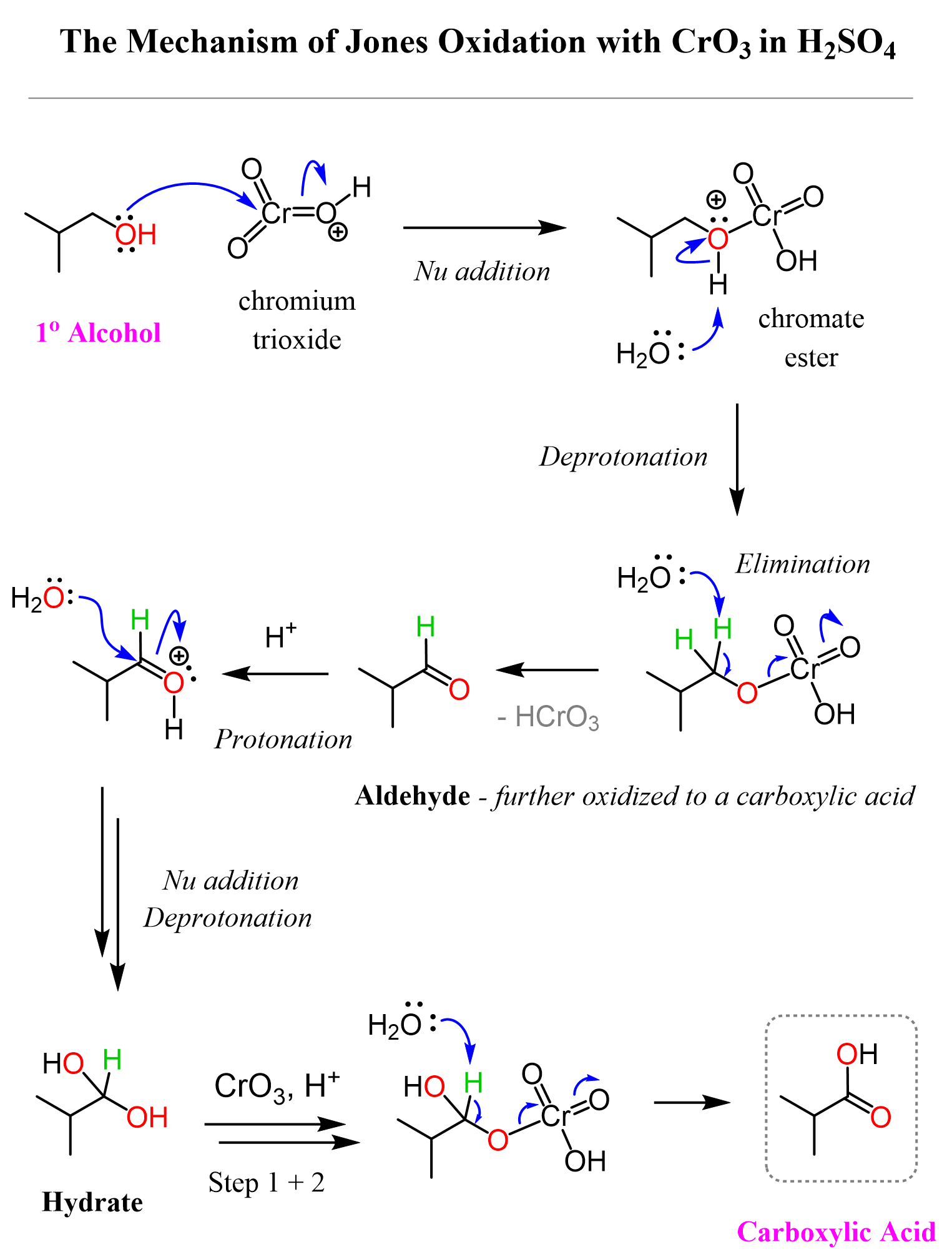Jones oxidation is the most common oxidation method for converting primary alcohols to carboxylic acids. It is carried out either by CrO3 in H2SO4, chromic acid itself, or a dichromate salt such as Na2Cr2O7 in the presence of sulfuric acid.
The Mechanism of Jones Oxidation
The reaction starts with a nucleophilic addition of the alcohol to the protonated chromic oxide, forming a chromate ester. The Cr component of the ester is a good leaving group, which promotes an elimination reaction, forming the C=O bond of the intermediate aldehyde. Once the aldehyde is formed, it is converted into a hydrate via nucleophilic addition of water. The hydrate reacts just like the alcohol in the first part of the reaction, and the final product, carboxylic acid, is formed.

Jones Oxidation with Chromic Acid
As mentioned earlier, the reaction can also be carried out by using chromic acid itself, and follows the same pattern of converting the OH into a leaving group and an elimination forming the C=O double bond.

Because the oxidation of the alcohols goes all the way to carboxylic acid, Jones reagent is considered to be a strong oxidizing agent. We can use what is called a mild oxidizing agent, such as PCC, PDC, DMP, etc., to selectively convert primary alcohols to aldehydes.

Notice that secondary alcohols are oxidized to ketones regardless of whether a strong or a weak oxidizing agent is used. Tertiary alcohols cannot be oxidized.
Check out this comprehensive article for the selectivity and mechanism of the most common oxidizing agents you need for your organic chemistry class.
Check Also
- Nomenclature of Alcohols: Naming Alcohols based on IUPAC Rules with Practice Problems
- Preparation of Alcohols via Substitution or Addition Reactions
- Reaction of Alcohols with HCl, HBr, and HI Acids
- Mesylates and Tosylates as Good Leaving Groups
- SOCl2 and PBr3 for Conversion of Alcohols to Alkyl Halides
- Alcohols in Substitution Reactions Practice Problems
- POCl3 for Dehydration of Alcohols
- Dehydration of Alcohols by E1 and E2 Elimination
- The Oxidation States of Organic Compounds
- LiAlH4 and NaBH4 Carbonyl Reduction Mechanism
- Alcohols from Carbonyl Reductions – Practice Problems
- Grignard Reaction in Preparing Alcohols with Practice Problems
- Grignard Reaction in Organic Synthesis with Practice Problems
- Protecting Groups For Alcohols in Organic Synthesis
- Oxidation of Alcohols: PCC, PDC, CrO3, DMP, Swern, and All of That
- Diols: Nomenclature, Preparation, and Reactions
- NaIO4 Oxidative Cleavage of Diols
- The Pinacol Rearrangement
- The Williamson Ether Synthesis
- Alcohol Reactions Practice Problems
- Naming Thiols and Sulfides
- Reactions of Thiols
- Alcohols Quiz – Naming, Preparation, and Reactions
- Reactions Map of Alcohols
